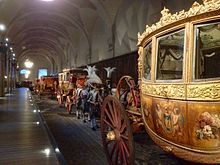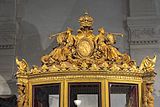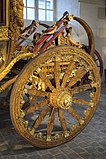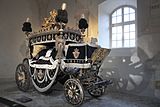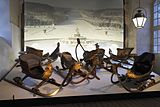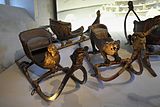Carriage Museum (Versailles)
The Carriage Museum (French: Galerie des Carrosses ) of the Palace of Versailles in the greater Paris area was founded in the 19th century by the French King Louis-Philippe and was originally housed in a building in the palace park. In 1985 the Carriage Museum was opened on the Place d'Armes opposite the castle in a wing of the Grande Écurie . After years of closure and renovation, it reopened on May 10, 2016.
history
In 1831 the so-called Citizen King Louis-Philippe decided to transform the Palace of Versailles into a museum "a toutes les gloires de la France" (in honor of France). In 1837 the museum, which also included a collection of carriages, was inaugurated. Until the French Revolution of 1789 there were over 2000 carriages in the royal stables. In 1851 the carriage collection was expanded to include sedan chairs and sleighs and opened to the public in a building erected by Charles-Auguste Questel near the two castles Petit and Grand Trianon in the park of Versailles. In 1978 the collection was moved to the Grande Écurie, the great stables that Jules Hardouin-Mansart built between 1679 and 1682 for the court's riding horses. The old exhibition building in the castle park was demolished. In 1985 the new Carriage Museum, which could only be visited on weekends, opened in its current building. In 2007 it was closed. The museum, which was reopened in 2016, has an exhibition area of 1000 m² and can be visited in the afternoon from Tuesday to Sunday. Admission is free.
collection
Carriages of the wedding parade of Napoleon I.
The collection mainly includes carriages from the 19th century. The Berliners La Cornaline and L'Améthiste were part of the splendid wedding parade that took place on the occasion of the marriage of Napoleon I to Marie-Louise of Austria on April 2, 1810 on the Avenue des Champs-Élysées to the Tuileries Garden and with 40 carriages with over 240 horses were involved.
Berline for the baptism of Henri d'Artois (Duke of Bordeaux)
The baptism of Henri d'Artois , the posthumously born son of the murdered Duke of Berry and grandson of Charles X , who as Henry V should have secured the succession to the throne and the continued existence of the Bourbon dynasty , was the occasion for an extraordinarily splendid celebration. The newborn was celebrated as “l'enfant du miracle” (child of the miracle). The baptism took place on May 1, 1821 in the Notre-Dame Cathedral in Paris. The eagles on the four corners of the roof of the carriage are a reminder of their re-use at the baptism of Napoleon III's son. in 1856.
Carriage for the coronation of Charles X.
The carriage was originally intended for the coronation of Louis XVIII. be built, which, however, renounced a coronation. The carriage was only completed after his younger brother and successor had ascended to the throne. In the carriage drawn by eight horses, Charles X drove to Reims Cathedral on May 29, 1825 , where the coronation ceremony took place. On June 6 of the same year he entered Paris in this coach. Separate wheels were used to transport the carriage from Paris to Reims, which can also be seen in the exhibition. The magnificent wheels were only installed in Reims. In 1856, on the occasion of the baptism of Napoléon Eugène Louis Bonaparte , the son of Napoleon III. , utilized. The royal insignia was then replaced by that of the Second Empire . The four corners are studded with horns of plenty from which caryatids rise. On the roof, four phemas surround the royal crown. They hold a crest cartouche that was originally provided with the royal initials. The sides are decorated with allegorical paintings.
Hearse of Louis XVIII.
In this carriage, the body of the king, who died on September 16, 1824, was transported in a solemn procession from the Palais des Tuileries to the royal burial place in the former abbey church of Saint-Denis . The funeral procession took place on September 23, 1824. It was the last funeral of a French king in France, the successors of Louis XVIII. died in exile. Four caryatids in angelic form hold palm fronds as a symbol of the resurrection. Angels are depicted on the roof, carrying the royal crown on their backs and holding an upturned torch in their hands as a sign of death.
Sledge
All three monarchs, from Louis XIV to Louis XVI., Enjoyed sleigh races in the palace gardens of Versailles in winter. The oldest sledges in the museum date from the first half of the 18th century. They were pulled by horses; the driver sat on a little box behind the sleigh.
Children's carriages
The children's carriages were exact replicas of the large carriages. They were made by famous carriage makers and were equipped with precious materials and all technical subtleties. The carriages for children were either pulled by adults or by sheep, goats or dogs. All of the royal children owned children's carriages, the carriages on display belonged to the children of Louis XVI. and Marie-Antoinette .
Sedan chairs
Sedan chairs were already in use in antiquity, and their use spread throughout Europe at the end of the 16th century. In Paris it was possible to rent public sedan chairs at predetermined prices since 1617. In Versailles, public and private sedan chairs were used in the park and also inside the palace. In some areas of the palace, only the litters of the royal family were allowed.
Web links
- Réouverture de la galerie des Carrosses Château de Versailles (accessed October 26, 2016, in French)
- La Galerie des Carosses. Grande Écurie du Roi Château de Versailles, brochure of the Carriage Museum (accessed October 26, 2016, French)
- Fabien Oppermann: Les tribulations des écuries du Roi, Versailles au XXe siècle . In: Livraisons d'histoire de l'architecture . N ° 6, 2003, pp. 99-108 (accessed October 26, 2016, French)
Individual evidence
- ↑ La collection du musée des voitures de Versailles en 1851 attelage-patrimoine (accessed on October 26, 2016, in French)
- ↑ Le musée des Carrosses Etablissement public du musée et du domaine national de Versailles. Dossier de Presse p. 26 and p. 30 (accessed on October 26, 2016, in French)
- ^ Musée des voitures historiques à Versailles. Le Sacre attelage-patrimoine (accessed October 26, 2016, French)
- ↑ Musée des carrosses de Versailles. Char funèbre de Louis XVIII attelage-patrimoine (accessed October 26, 2016, in French)
- ↑ Musée des carrosses de Versailles. Traineaux attelage-patrimoine (accessed October 26, 2016, French)
Coordinates: 48 ° 48 ′ 13.6 " N , 2 ° 7 ′ 41.8" E

